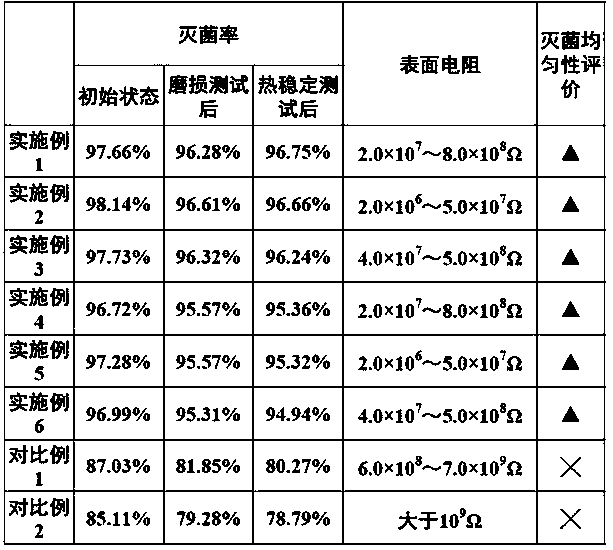A kind of antistatic antibacterial ceramic glaze and preparation method thereof
An antibacterial ceramic and antistatic technology, applied in the field of ceramics, can solve problems such as limited application range, lack of multiple functions, and unsatisfactory effects, and achieve the effects of broadening the application range, long-term antibacterial activity, and preventing agglomeration
- Summary
- Abstract
- Description
- Claims
- Application Information
AI Technical Summary
Problems solved by technology
Method used
Image
Examples
Embodiment 1
[0028] An antistatic and antibacterial ceramic glaze and a preparation method thereof, the preparation method comprising the steps of:
[0029] Step A, preparing low-temperature frit: by mass percentage, 10% potassium nitrate, 7% quartz, 12% potassium feldspar, 5% albite feldspar, 10% spodumene, 30% boric acid, 5% barium carbonate, 8% fluorite, 3% kaolin, 2% sodium fluoride and 8% antibacterial / antistatic functional agent are mixed evenly, after sieving, grinding and mixing, they are calcined at 1250-1300°C and then rapidly quenched to obtain a melting temperature of 650 ~800℃ low-temperature frit;
[0030] Step B, preparing antistatic and antibacterial glaze slurry: by mass percentage, 30% low-temperature frit, 30% potassium feldspar, 10% quartz, 5% calcite, 8% talc, 4% calcium phosphate, 5% kaolin, 8 % Calcined soil is mixed to obtain mixed powder, and antibacterial / antistatic functional agent is added to the mixed powder and mixed evenly, finely ground to 300~350 mesh, the...
Embodiment 2
[0042] An antistatic and antibacterial ceramic glaze and a preparation method thereof, the preparation method comprising the steps of:
[0043] Step A, preparing low-temperature frit: by mass percentage, 8% potassium nitrate, 8% quartz, 10% potassium feldspar, 6% albite feldspar, 11% spodumene, 35% boric acid, 4% barium carbonate, 7% fluorite, 2% kaolin, 4% sodium fluoride and 5% antibacterial / antistatic functional agent are mixed evenly, after sieving, grinding and mixing, they are calcined at 1250-1300°C and then rapidly quenched to obtain a melting temperature of 650 ~800℃ low-temperature frit;
[0044] Step B, preparing antistatic and antibacterial glaze slurry: by mass percentage, 25% low-temperature frit, 35% potassium feldspar, 15% quartz, 3% calcite, 5% talc, 4% calcium phosphate, 3% kaolin, 10 % Calcined soil is mixed to obtain mixed powder, and antibacterial / antistatic functional agent is added to the mixed powder and mixed evenly, finely ground to 300~350 mesh, then ...
Embodiment 3
[0056] An antistatic and antibacterial ceramic glaze and a preparation method thereof, the preparation method comprising the steps of:
[0057] Step A, preparing low-temperature frit: by mass percentage, 6% potassium nitrate, 10% quartz, 15% potassium feldspar, 8% albite feldspar, 11% spodumene, 33% boric acid, 3% barium carbonate, 5% fluorite, 1% kaolin, 5% sodium fluoride and 3% antibacterial / antistatic functional agent are mixed evenly, after sieving, grinding and mixing, they are calcined at 1250-1300°C and then rapidly quenched to obtain a melting temperature of 650 ~800℃ low-temperature frit;
[0058] Step B, preparing antistatic and antibacterial glaze slurry: by mass percentage, 20% low-temperature frit, 40% potassium feldspar, 20% quartz, 1% calcite, 3% talc, 5% calcium phosphate, 3% kaolin, 8 % Calcined soil is mixed to obtain mixed powder, and antibacterial / antistatic functional agent is added to the mixed powder and mixed evenly, finely ground to 300~350 mesh, the...
PUM
 Login to View More
Login to View More Abstract
Description
Claims
Application Information
 Login to View More
Login to View More - R&D
- Intellectual Property
- Life Sciences
- Materials
- Tech Scout
- Unparalleled Data Quality
- Higher Quality Content
- 60% Fewer Hallucinations
Browse by: Latest US Patents, China's latest patents, Technical Efficacy Thesaurus, Application Domain, Technology Topic, Popular Technical Reports.
© 2025 PatSnap. All rights reserved.Legal|Privacy policy|Modern Slavery Act Transparency Statement|Sitemap|About US| Contact US: help@patsnap.com

